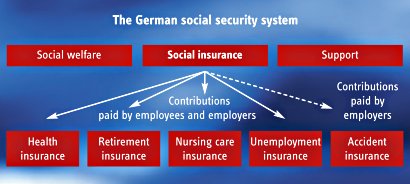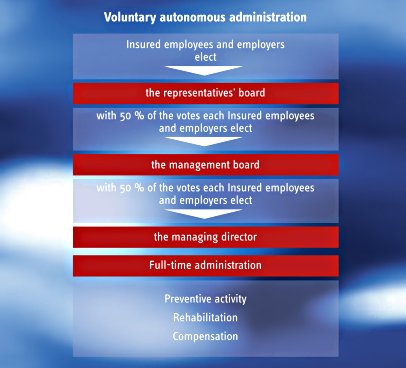Abschnitt 1 BGI/GUV-I 506 E - I. The German statutory accident insurance institutions - who we are.
Organization and function
Many people in Germany enjoy its protection, yet only a small minority are even aware that it exists: the German statutory accident insurance system. It provides insurance against occupational and commuting accidents, and against occupational diseases. Besides employees, trainees, agricultural-sector employers and their families, other groups of persons are also insured, including schoolchildren, students at vocational colleges and other institutes of higher education, and children in nursery schools and after-school care centres.
With over 70 million insured persons, it constitutes an important branch of the social insurance system. Nevertheless, the public is barely aware of it, for a very simple reason: it is the only form of (mandatory) insurance for which the insured individuals themselves pay no contributions. Instead, the cost is bone entirely by their employers, or in the case of schools and public administrations, by the federal, regional and local authorities.
The insurance covers not one party, but two: in the event of a commuting, school or occupational accident or an occupational disease, the insured individual benefits from full cover for the provision of both acute medical care and, if necessary, rehabilitation and compensation or a pension. At the same time, companies and institutions at which the insured person is employed are absolved of any liability, since this is assumed in full by the statutory accident insurance system. By paying his contributions and taking effective preventive measures, the employer thus meets his statutory obligations to his staff.

The basis for the statutory accident insurance institutions' activities is the German Social Code VII. The first of their functions is that of preventing occupational accidents, occupational diseases, and work-related health hazards. At the same time, should an occupational accident or disease nevertheless occur, they employ all suitable means to restore the health and performance of the insured individual.

Karola Lindequist, flight attendant, Air Berlin:
"We can offer our passengers outstanding service only if we are healthy. The prevention services of our statutory accident insurance institution help us to achieve this."

Like statutory health, retirement, nursing care and unemployment insurance, statutory accident insurance is also mandatory. Its statutory basis is the German Social Code, particularly Volume 7 (SGB VII). It cannot be substituted by a private accident or liability insurance policy.
Practical tip
Founding a company
Each employer is obliged to assume responsibility for the safety and health of his personnel. After founding a company, he must report its creation to the responsible accident insurance institution within one week. Premiums are payable only if he employs staff.
Information on the procedure and on which statutory accident insurance institution or public-sector accident insurer is responsible can be obtained from the individual statutory accident insurance institutions or the DGUV.
The statutory accident insurance institutions in the industrial sector and the public-sector accident insurers: the pillars of the statutory accident insurance system
On a day-to-day basis, the statutory accident insurance function is fulfilled by the statutory accident insurance institutions in the industrial and agricultural sector and the public-sector accident insurers. These institutions assume responsibility for people who have suffered:
An occupational accident
A commuting accident
An accident at a school, nursery school, after-school care centre or institute of higher education
An occupational disease
The insurance cover they provide extends to all salaried employees, children in educational establishments, students, and domestic helps and voluntary workers. Benefits begin directly with primary medical care and extend, where necessary, through rehabilitation to compensation in the form of a pension. Resources are also available for social and vocational rehabilitation. The statutory accident insurance system adheres to the principle of "rehabilitation before pensions". This means that a modern rehabilitation approach is followed, the objective of which is for the victim of an occupational accident or disease to be able to return to their profession and to retain as much control as possible over their own life.
The statutory accident insurance institutions in the industrial sector are organized on sectoral lines. They are responsible for all businesses in the commercial sector, approximately three million in number. Each of the public-sector accident insurers is generally responsible for one particular German region. The public-sector accident insurers responsible for the fire services serve several regions; those for the railway services, the postal and telecommunications services, and the insurer of the Federal authorities themselves are organized at national level. Around 28 million people, including all children in schools, nursery schools and after-school care centres, and students in higher education, fall within the responsibility of the public-sector accident insurers.
The statutory accident insurance institutions in the industrial sector and the public-sector accident insurers are members of an umbrella association, the "German Social Accident Insurance" (DGUV), which represents their interests, for example at political level.

In addition, the DGUV supports its members in all issues of a generic nature, develops common measures for prevention, promotes the ongoing development of rehabilitation, and addresses new methods and approaches in education and training. Last but not least, the DGUV maintains its own research institutes, which are specialized in the complex causal relationships of occupational exposure and health risks. In addition, suitable projects conducted by third parties are sponsored by a programme of research funding.
Info:
Background
Since 1 June 2007, the statutory accident insurance institutions for the industrial sector and the public-sector accident insurers have been represented by a common umbrella association. The newly created DGUV (German Social Accident Insurance), located in Berlin, is the product of the merger between the HVBG (the Federation of Institutions for Statutory Accident Insurance and Prevention) and the BUK (the Central Federation of Public-Sector Accident Insurers). The DGUV maintains offices in Sankt Augustin and Munich in addition to those in Berlin. It also maintains institutes and academies at sites in Bad Hersfeld, Bochum, Dresden, Hennef and Sankt Augustin.
Internet: www.dguv.de
Prevention is better than cure
Every year, almost a million reportable occupational accidents occur in the public and private sector, and around 1.3 million reportable accidents in educational establishments. This is despite the fact that over the last twenty years, the risk of suffering injury at work or in school has fallen by more than half.
It is important to consider that these figures represent the fate of many individual human beings. The primary objective must therefore be that of reducing accidents and disease even further, notwithstanding the success that has clearly already been achieved. It is therefore appropriate that the statutory accident insurance institutions make great efforts to be effective in preventing occupational accidents, occupational diseases and work- related health hazards.
Preventive activity is defined by law as one of the functions of the statutory accident insurance institutions in the industrial sector and the public-sector accident insurers. In conjunction with those involved at local level - such as safety professionals, safety officers and company physicians - efforts are made to raise the awareness of management, employees, teaching and childcare staff and children for the hazards which they face on a daily basis, and to encourage them to adopt cautious behaviour. Responsibility within a company for the taking of preventive measures lies with the employer. He is supported in this task however by specialists from his "own" statutory accident insurance institution or public-sector accident insurer, who advise, inspect and provide information.
In addition, highly specialized experts at the research institutes of the statutory accident insurance system continually work on improving products and procedures - often in co-operation with manufacturers - in order to provide greater protection and safety for insured individuals (see also Chapter V).
Reinhard Gurke, head firefighter, Fürstenwalde fire service:
"The aspect of safety is of increasing importance in training. In my opinion, that's a good thing: we want to come home safely after a call-out, too."

Exploiting practical experience
The organizational form of the statutory accident insurance system is also a product of the preventive concept: statutory accident insurance institutions for the industrial sector and the public-sector accident insurers are incorporated under public law. They fulfil their statutory functions by means of an autonomous administration, a form of management in which employers and insured individuals (employees) enjoy equal rights. This ensures that the interests of employers and insured employees are respected in equal measure. The task of legal supervision lies with the state. Social elections are held every six years at which the employers and insured individuals elect their delegates to the representatives' boards of the relevant accident insurance institutions.
The representatives' board formulates the charter and by-laws of the autonomous administration. It elects the management board. Employers' and employees' delegates are represented in equal number on both the representatives' board and the management board. The social partners must consequently reach agreement on all major issues. The administration of each accident insurance institution is headed by a managing director. The managing director is an advisory member of the management board and is responsible for day-to-day administration.
The members of the autonomous administration determine the budget, the hazard tariff and the staffing schedule of the administrations. This ensures a maximum of cost and expenditure transparency for the statutory accident insurance system. Employers' and employees' delegates are also present on the committees which rule on compensation payments, for example pensions.
The success of the statutory accident insurance system to date - above all in the area of preventive activity - is attributable to the close links between its work and the field. The statutory accident insurance institutions for the industrial sector and the public-sector accident insurers are not anonymous bureaucracies, but are managed by dedicated autonomous administrations comprising delegates who represent employers and insured persons. Both sides contribute their practical and sector-specific experience, to the benefit of all involved.

